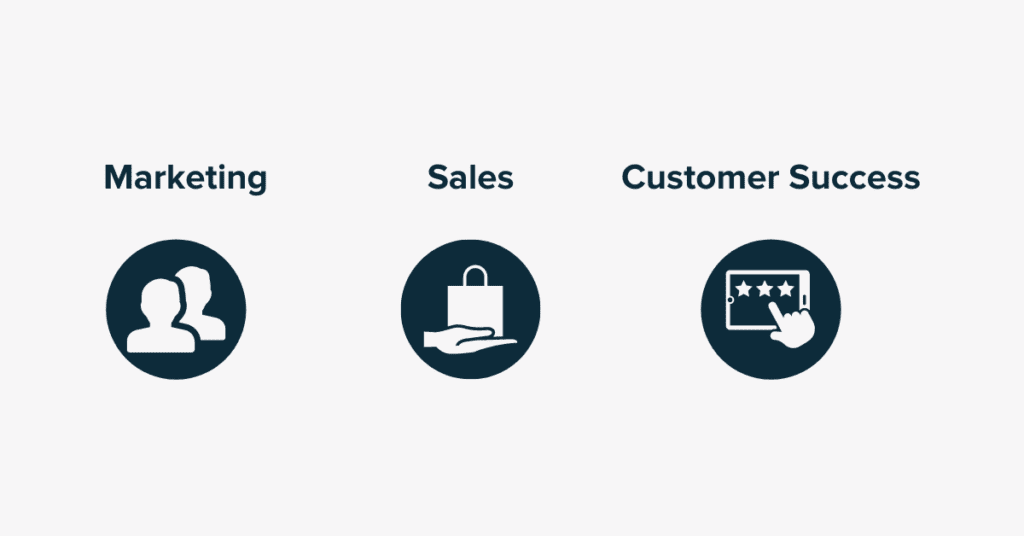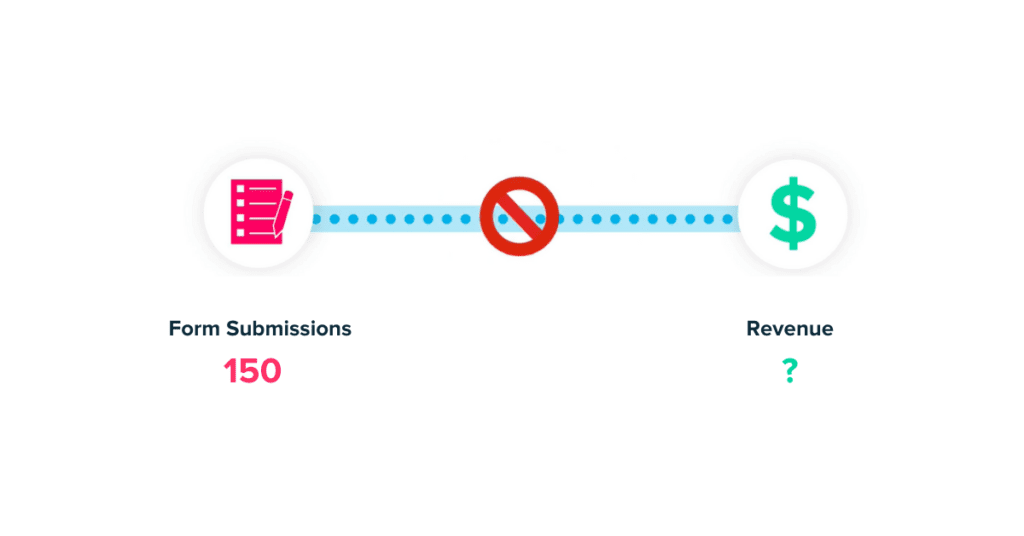Revenue operations, or RevOps, is transforming the way businesses look at their revenue generation.
Sales and marketing alignment is no mean feat.
And with more and more data at play, understanding revenue and connecting it through all parts of the business is more important than ever.
So it’s no surprise that more businesses are focusing on revenue operations as its own function.
Just take a look at LinkedIn.
It’s clear to see how revenue operations has grown.
There’s been a huge surge in job titles related to RevOps and it’s showing no sign of slowing down.
But what actually is it and how can it help your business?
In this blog, we’ll show teach you more about
So, let’s get started.
First off, what even is revenue operations?
Revenue operations, or RevOps, is a strategy used to get your sales, marketing and customer success teams working in tandem.
RevOps creates streamlined processes, identifies common metrics and allows teams to use the same tools to allow focus on revenue generation.
There are three key areas to focus on aligning; people, data and processes:
Let’s use a fictitious company as an example.
Company A has a marketing team, a sales team and a customer success team.
The marketing team works to drive leads for the sales team.
The sales team tries to convert those leads into sales.
Once converted, they’re passed to the customer success team.
As such, each team has different metrics and targets to work towards.

For marketing, it’s leads. Driving a large volume of leads might be a tick for marketing, but what does it mean for sales?
Related: How we increased marketing-source revenue by 96%
What if the leads being produced are low quality? That means the sales team are wasting precious time on leads that won’t ever convert.
Meanwhile, when a sales team converts a lead, it’s passed to customer success.
But how do those teams work together to drive more revenue from that customer? In reality, they don’t work together at all.
Sales could end up closing poor fit clients who end up churning quickly.
So, ensuring the right fit of lead at every stage is vital.
Revenue operations allows you to align your team around a single view and give them one key target to achieve together.
Data is an important commodity for any business.
But for Company A’s marketing, sales and success team, they all look at different data and see a huge data disconnect across the customer journey.
Related: Complete guide to customer journey stages
Let’s break it down.
Marketing drive leads. We know this.
But how can they know what they’re doing is driving leads?
Related: How to link leads back to revenue
They might be able to track conversions, like form fills, phone calls etc.
But, while you see one new conversion, you don’t know what lead that relates to.
And, you don’t know where they came from.
Was it from a PPC campaign? From an email marketing send? Maybe from social media?

Leads are thrown over the wall to sales. And they get little data too.
Without a lead source, they can’t tailor their sales messaging.
Related: How to track your lead source
But the problems don’t end there.
When a lead converts into revenue, marketing gets no oversight of what their efforts have achieved.
And without attribution, they couldn’t see revenue placed against individual leads anyway.
⚡️Pro Tip
Want to know more about marketing attribution? See how Ruler can link all of your leads to your revenue. And even better, track every touchpoint so that you can see how marketing channels have influenced your sales.
With all of these individual metrics and teams, it’s no surprise that processes are an issue too.
How does marketing pass leads to sales?
And how do sales pass new customers to customer success?
Communication is key. But when you have large teams, and large volumes of leads and customers, it can be tricky to keep track.
Related: 6 revenue metrics you need to track
Revenue operations allows you to streamline your processes and ensure your teams are working as one.
This can be done as simply as having combined meetings, using shared tools to manage workloads or integrating cadences across teams.
Without a RevOps team and system in place, common pain points tend to crop up. If any of the following issues sound familiar, then you probably need revenue operations:
This is a typical problem for teams working without RevOps.
This strategy allows you to consolidate your tools under one team.
It means less wasted budget on tools for different teams that are essentially doing the same job and means better, shared data.
Do you hear complaints from sales that they aren’t getting enough leads?
Or complaints from marketing that leads aren’t being picked up?
Pushing leads through the pipeline shouldn’t be this difficult.
Revenue operations ensures everyone knows who’s working on what, and that data is given to the right people, at the right time.
This is a common issue for teams who don’t need revenue operations too.
Do you struggle to understand what’s driving leads, or even more crucially, what’s driving revenue?
Related: How to track marketing ROI
Revenue operations, combined with marketing attribution, allows your teams to unlock the data they need and fire it to where they need it most.
Day to day, revenue operations liaise with marketing, sales and customer success teams.
They align revenue strategy across these departments and act as a single source of truth to internal stakeholders.
It means they’re responsible for ensuring that revenue is properly accounted for, and that tools and systems have one central owner.
By doing this, you can ensure that tools and processes are kept up to date and that the right data is flowing in and out of the tools you need it to.
Having a revenue operations department in place can help you:
Is this not what your marketing, sales and success teams should all be striving for? Without revenue operations, it’s hard to optimise for revenue.
The data disconnect, missed metrics and siloed teams makes it hard to understand where your customers are coming from.
Marketing attribution tools allow you to break this disconnect. Then, your teams will be able to optimise their processes and outputs to drive more revenue.
It’s critical to be able to predict your business growth and revenue income. It allows you to confidently invest your budget as you can understand what’s working and what isn’t.
RevOps brings this predictability to your growth through accurate and consistent measurements.
When your teams are working harmoniously to the same goals, the impact on your customers is going to be great.
Strong teamwork means your teams will be more attuned to their customers’ needs.
And happy customers are a great indicator of strong customer outcomes. Customer outcomes are the successes your customers see by using your product or service.
Impact that and you can be sure to increase business.
The main difference between revenue ops and sales ops is that sales operations primarily supports the B2B sales process. Meanwhile, revenue operations are responsible for the entire revenue-generating team.
Revenue operations will do the same functions as sales ops, but they will also carry it out across marketing and customer success.
The primary goal of RevOps is to make revenue-generating teams more efficient and effective.
Revenue operations is all about numbers. So, here are some of the metrics you’ll need to take note of when working in RevOps:
Tracking these metrics regularly can help you stay on top of ebbs and flows team to team and highlight areas that need attention.
The reason marketing, sales and customer success struggle so much with alignment is because of difficult data flows.
So, investing in the right tools can help your revenue operations team flourish.
Some revenue operations tools you might want to consider are:
CRM: To manage leads and customers throughout their customer lifecycle
Marketing attribution: To track revenue and prove marketing impact on sales
Revenue analytics: To gather information via workflows to improve processes
AI-powered analytics: To manipulate large datasets and get automated suggestions and insights
🚀 Pro Tip
Ruler Analytics is a marketing attribution tool that can offer your revenue analytics features as well as machine learning functionality on your revenue data. Learn more by booking a demo with our team.
Revenue operations have been growing in popularity but it’s not easy to get right.
Hopefully, this guide goes some way to help you understand if your business needs RevOps and how to implement it.
Stay ahead of the curve and optimise your processes using real data. By working together, who knows what your business is capable of achieving!
Don’t forget to check out some of our related blogs. We write about a whole wealth of topics from attribution and reporting, to PPC, social and marketing trends.